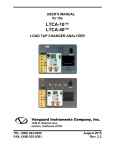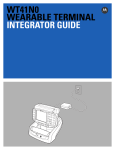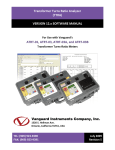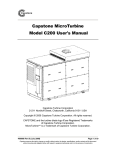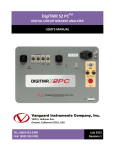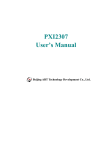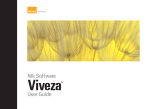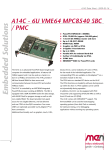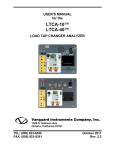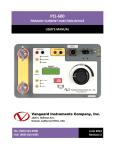Download LTCA Software Manual - Vanguard Instruments Company, Inc.
Transcript
VANGUARD LOAD TAP CHANGER ANALYZER (LTCA) VERSION 2.xx SOFTWARE MANUAL For Use with Vanguard’s LTCA-10, LTCA-40, WRM-10P, WRM-40, TRM-20, TRM-40, TRM-203, and TRM-403 Load Tap Changer Analyzers and Winding Resistance Meters Vanguard Instruments Company, Inc. 1520 S. Hellman Ave. Ontario, California 91761, USA TEL: (909) 923-9390 FAX: (909) 923-9391 January 2015 Revision 4.3 LTCA VERSION 2.xx SOFTWARE MANUAL REV 4 TABLE OF CONTENTS CONVENTIONS USED IN THIS DOCUMENT ................................................................................................... 1 1.0 INTRODUCTION ................................................................................................................................. 2 1.1 System Requirements ................................................................................................................... 2 2.0 SOFTWARE INSTALLATION ................................................................................................................ 3 3.0 STARTING THE LTCA SOFTWARE ....................................................................................................... 6 3.1 LTCA Software User Interface Elements ....................................................................................... 7 3.2 Keyboard Shortcuts ...................................................................................................................... 9 3.3 Application Setup........................................................................................................................ 10 3.4 Printer Setup ............................................................................................................................... 24 4.0 WORKING WITH TEST RECORDS ..................................................................................................... 25 4.1 Retrieving Test Records From an LTCA, WRM, or TRM .............................................................. 25 4.2 Recalling Test Records From the PC Hard Drive ......................................................................... 27 4.3 Saving a Test Record ................................................................................................................... 28 4.3.1. Saving a Test Record with its Original File Name ................................................................ 28 4.3.2. Saving a Test Record with a Different File Name ................................................................ 28 4.4 Exporting Test Records ............................................................................................................... 29 4.5 Viewing and Working with Static Test Results ........................................................................... 32 4.5.1. Working with Test Reports ................................................................................................. 34 4.6.3. Viewing a Graph Expansion................................................................................................. 53 4.6.4. Overlaying Test Results Graphs .................................................................................................. 55 4.7 Working with Dynamic Test Results (LTCA and TRM) ................................................................ 58 4.7.1. Working with Dynamic Test Results Data Points (LTCA and TRM) ..................................... 61 5.0 PERFORMING TESTS ........................................................................................................................ 66 5.1 Running a Static Resistance Test ................................................................................................ 66 5.2 Running an LTCA/Voltage Regulator Resistance Test................................................................. 73 5.3 Running a Dynamic Resistance Test (LTCA and TRM) ................................................................ 79 5.4 Demagnetizing the Transformer Core (TRM only) ..................................................................... 84 LIST OF FIGURES Figure 1. Typical Dynamic Resistance Graph with Overlay ......................................................................... 56 Figure 2. Typical Static Resistance Graph with Overlay .............................................................................. 57 i REV 4 LTCA VERSION 2.xx SOFTWARE MANUAL CONVENTIONS USED IN THIS DOCUMENT This document uses the following conventions: • All versions of Microsoft® Windows will be simply referred to as Windows in this manual. If any information or instructions pertain to a specific version of Windows, the specific name will be used. • The term “LTCA” will be used to refer to both the LTCA-10 and LTCA-40. If any information or instructions pertain to a specific model, the specific model name will be used. The term “WRM” will be used to refer to both the WRM-10P and WRM-40. If any information or instructions pertain to a specific model, the specific model name will be used. The term “TRM” will be used to refer to the TRM-20, TRM-40, TRM-203, and TRM-403. If any information or instructions pertain to a specific model, the specific model name will be used. • • • • • • • • • Menu Names and icons are referred to as Menu Name and Icon Menu items are referred to as Menu Item Dialog boxes and their elements (buttons, options, etc.) are referred to as “Dialog Box Element” PC keyboard keys are referred to as [Key]. Key combinations are shown as [Key]+[Key]. A key or switch on the LTCA or WRM is indicated as [KEY] File locations, directories, and file names are shown as “C:\folder\filename” Warning messages are indicated as: Warning message WARNING • Important notes are indicated as: Note details NOTE Microsoft, Windows, Windows XP, Windows Vista, and Windows 7 are either registered trademarks or trademarks of Microsoft Corporation in the United States and/or other countries. All other trademarks are the property of their respective owners. 1 LTCA VERSION 2.xx SOFTWARE MANUAL 1.0 REV 4 INTRODUCTION The Vanguard Load Tap Changer Analyzer (LTCA) software is a Windows-based PC software application for use with Vanguard’s line of load tap changer analyzers and winding resistance meters. This software allows users to perform the following tasks: • • • • • • 1.1 Retrieve Test Records from an LTCA, WRM, or TRM Analyze Retrieved Test Records View Test Results in Graphic Format Export Retrieved Test Records Print Retrieved Test Records Run tests from the PC System Requirements The LTCA software has the following minimum system requirements: • • • PC running Microsoft® Windows® XP, Vista, 7, 8, or 8.1 CD-ROM or DVD-ROM drive (if installing from disc). You may also download the software from our site at http://www.vanguard-instruments.com. RS-232C serial port, USB port, or Bluetooth support (TRM’s only) 2 REV 4 2.0 LTCA VERSION 2.xx SOFTWARE MANUAL SOFTWARE INSTALLATION Follow the steps below to install the LTCA software on your PC. 1. Insert the installation CD in the PC’s CD or DVD drive. 2. From the Windows Desktop, click on the “Start” button to bring up the Start Menu. 3. From the Start Menu, click on My Computer to open the My Computer window. 4. Double click (or single click in some Windows configurations) on your CD/DVD Drive icon to navigate the installation CD. The contents of the CD will be listed as shown below: 5. Double click (or single click in some Windows configurations) on the “LTCA PC Software Rev 2.x.exe” file to start the installation process. The LTCA Setup Wizard will appear as shown below: 3 LTCA VERSION 2.xx SOFTWARE MANUAL REV 4 6. Click on the “Next” button to continue. The following screen will be displayed showing the location on your hard drive where the software will be installed (C:\Vanguard\LTCA): 7. You may choose a different installation location by clicking on the “Browse…” button and then browsing to the location on your hard drive where you would like to install the software. If you would like to install the software in the default location, click on the “Install” button to continue. The installation progress window will be displayed: 4 REV 4 LTCA VERSION 2.xx SOFTWARE MANUAL NOTE The LTCA 2 software requires Microsoft .NET 4.x to be installed on your computer. If Microsoft .NET 4.x is not installed on your computer, it will be installed automatically. 8. The following screen will be displayed once the software has been successfully installed: 9. If you would like to run the LTCA software now, check the “Run LTCA 2.xx” checkbox. Click on the “Finish” button to close the InstallShield Wizard and complete the installation process. 5 LTCA VERSION 2.xx SOFTWARE MANUAL 3.0 REV 4 STARTING THE LTCA SOFTWARE Windows 8.1 [ STUB ] Windows 8 [ STUB ] Windows 7 and Earlier During the installation process, a Vanguard program group will be created under the All Programs submenu in the Windows Start menu. To launch the LTCA software: 1. Click on the Windows “Start” menu button to open the Start Menu. 2. Click on the All Programs menu item. 3. Click on the Vanguard menu item. 4. Click on the LTCA menu item. 5. Click on the Launch ltca.exe menu item. The LTCA main application window will appear as shown below: 6 REV 4 3.1 LTCA VERSION 2.xx SOFTWARE MANUAL LTCA Software User Interface Elements 1. File Menu: You can open, close, save, and print test records from the file menu. 2. New Document: Click on this icon to create a new document (LTCA data or LTCA Graph). 3. Save: Click on this icon to save the current active test record. 4. Quick Print: Click on this icon to quickly print the active document using current options. 5. Open: Click on this icon to open a test record. 6. Quick Access Toolbar Options: Click on this menu to customize which icons (items 1-5 above) are displayed on the toolbar. 7. Main application ribbon. The ribbon houses the various application icons. Icons are grouped by their functionality. 8. View Report: Click on this button to view the test report for the current active test record. 9. View Graph: Click on this button to view the graph for the current active test record. 10. Windows: Click on this button to view a list of current open windows. 11. Run: Click on this button to start performing a test. The WRM, LTCA, or TRM unit must be connected to the PC. 12. Retrieve: Click on this button to retrieve a test record from a connected unit’s internal memory. 13. Open: Click on this button to open a test record file from the PC. 14. Edit: Click on this button to edit the current active test record’s header information and test notes. 15. Save: Click on this button to save the current active test record. 16. Overlay: Click on this button to overlay graphs from multiple test records. 7 LTCA VERSION 2.xx SOFTWARE MANUAL REV 4 17. Export: Click on this button to export the current test record data in XML, PDF, and Excel formats. 18. Settings: Click on this button to configure the application preferences such as graph colors, communications port, etc. 19. View 1:1: If you are zoomed in on a specific area on a graph, click on this button to zoom out to the full view. 20. Mode: When viewing a graph, you can select the graph viewing mode from this menu. The graph can be displayed using a linear or a logarithmic scale. 21. Edit Test Data Points: Click on this button to edit any stored test data points (for dynamic LTCA test records only) 22. Style: Click on this menu to select the user interface style. This affects the look and feel of the LTCA software. 23. Scale: Click on this menu to select the scale of the graph's Y-axis. 8 REV 4 3.2 LTCA VERSION 2.xx SOFTWARE MANUAL Keyboard Shortcuts Keyboard shortcuts are available for quick access to some of the menu options and icons. To use a keyboard shortcut, press the [ALT] key on the keyboard. The user interface will be updated with pop-ups over items that can be accessed using a keyboard shortcut as shown below: You can access the item under the pop-up by pressing the corresponding key on the keyboard. For example, press the [F] key to access the File Menu. The file menu will be displayed as shown below: Once again, pop-ups will be displayed over the menu items. To select a menu item, press the corresponding key indicated by the pop-up. For example, press the [O] key to select the Open… option. 9 LTCA VERSION 2.xx SOFTWARE MANUAL 3.3 REV 4 Application Setup Before using the LTCA program, the application setup parameters should be reviewed and changed as required. To change the setup parameters: 1. Make sure the LTCA software is running on the PC. 2. Click on the Settings icon on the ribbon (alternatively you can select Application Setup from the File menu). The following window will be displayed: a. Communications WRM-10P and WRM-40 Since the WRM-10P and WRM-40 feature only an RS-232C port, the “Use USB Port” check box should be un-checked. To configure the serial port settings, select the correct COM: port from the “COM Port:” drop-down list. 10 REV 4 LTCA VERSION 2.xx SOFTWARE MANUAL LTCA-10 and LTCA-40 If the LTCA is connected to the PC via the USB port, check the “Use USB port” checkbox. You can ignore the “COM Port:” drop down list. If the LTCA is connected to the PC via the RS-232C (serial) port, un-check the “Use USB port” check box and select the correct COM: port from the “COM Port:” dropdown list. TRM-20/40 and TRM-203/403 Connecting via USB: 1. Connect the TRM to the PC by connecting a USB cable from an open USB port on the PC to the unit’s “USB PC” port. 2. Turn on the power on the TRM. 3. If this is the first time you are connecting the unit to the PC, Windows will recognize it as a new device and automatically install necessary drivers. If using Windows XP, you may be prompted to install drivers. Select the automatic installation option and Windows will locate the necessary generic drivers. 4. Please note that although the unit is connected via USB, it uses an internal serial interface to communicate with the PC. As such, it will appear in the Windows Device Manager as a USB Serial Port. Open the Device Manager from the Windows Control Panel and note the COM port number. For example, in the installation shown below, the TRM is shown as COM10 (USB Serial Port). 11 LTCA VERSION 2.xx SOFTWARE MANUAL REV 4 5. Launch the LTCA application and then click on the “Settings” icon. The following window will be displayed: Make sure the “Use USB Port” option is UN-checked. Then, from the “COM Port” dropdown menu, select the COM port that corresponds to the port that the TRM is connected to. Then click the OK button. The LTCA software will now recognize the TRM. Connecting via Bluetooth: The TRM can also be connected wirelessly to a PC using Bluetooth. To connect the unit via Bluetooth, it must first be paired with the PC. Follow the steps below to pair the TRM to a PC via Bluetooth. Windows XP 1. Make sure the TRM is turned on. Then double click on the Bluetooth system tray icon (on the bottom right corner of your computer screen): 12 REV 4 LTCA VERSION 2.xx SOFTWARE MANUAL 2. The “My Bluetooth Places” window will be displayed: Click on “Add a Bluetooth Device” on the left window pane. 3. The Bluetooth Setup Wizard window will be displayed. Click on the “Next” button. The PC will scan for nearby devices and list all available Bluetooth devices: The TRM will be listed as “TRM S/N” where S/N is the device’s serial number. Click on the icon for the TRM and then click on the “Next” button. 13 LTCA VERSION 2.xx SOFTWARE MANUAL REV 4 4. The following window will be displayed asking for a secret key to connect to the TRM: Type the word “default” (without the quotes and in all lower-case) and then click on the “Next” button. 5. The following window will be displayed with the option to connect to the TRM as a serial port: Make sure to check the box next to “AT Serial” and then click on the “Next” button. 14 REV 4 LTCA VERSION 2.xx SOFTWARE MANUAL 6. The following confirmation screen will be displayed: Click on the “Finish” button. 7. The TRM will now be displayed in the “My Bluetooth Places” window: Note the port number listed under the device name. In the above case, the port number is COM14. Use this port number in the LTCA software to connect to the TRM. 15 LTCA VERSION 2.xx SOFTWARE MANUAL REV 4 Windows 7 and Later 1. Make sure the TRM is turned on. Then double click on the Bluetooth system tray icon (on the bottom right corner of your computer screen): 2. The “Bluetooth Devices” window will be displayed: Click on “Add a device”. 16 REV 4 LTCA VERSION 2.xx SOFTWARE MANUAL 3. All nearby Bluetooth devices will be listed: The TRM will be listed as “TRM S/N” where S/N is the device’s serial number. Click on the icon for the TRM and then click on the “Next” button. 4. The device pairing screen will be displayed: Click on “Enter the device’s pairing code” option. 17 LTCA VERSION 2.xx SOFTWARE MANUAL REV 4 5. The following window will be displayed: Type the word “default” (without the quotes and in all lower-case) in the text box and click on the “Next” button. 6. The following screen will be displayed: Click on the “Close” button. 18 REV 4 LTCA VERSION 2.xx SOFTWARE MANUAL 7. The TRM will now be listed under “Bluetooth Devices”: Right click on the TRM-20 icon and select “Properties” from the pop-up menu. 8. The properties window will be displayed. Click on the “Hardware” tab: Note the port number listed after the device (COM23 in the above example). Use this port number in the LTCA software to connect to the TRM. 19 LTCA VERSION 2.xx SOFTWARE MANUAL REV 4 b. Graph and Overlay Settings The LTCA software can overlay graphs from up to three test records. The graph for the first loaded test record is referred to as the “Main Graph”. Additional overlain graphs are referred to as “Overlay #1” and “Overlay #2”. You can customize the colors for the main graph and overlay graph elements by clicking on the color drop down menu next to the element’s name. For each item, a color selector will be displayed as shown: You can select a color from the pre-set colors shown or click on “Other” for more colors. The following color picker will be displayed: If you would like to pick a completely custom color, you can click on the “Custom” tab. The following color picker will be displayed: 20 REV 4 LTCA VERSION 2.xx SOFTWARE MANUAL You can also select a color from any pixel on the screen by clicking on the “Select...” button. This will turn your mouse cursor into an eyedropper. Move the eyedropper over an area on the screen and the underlying color will be displayed in the “New” color swatch area in the “Colors” window. When you have found the color you like, click to select it. WRM-10P and WRM-40 The WRM is capable of reading two static resistance values at the same time, and their values are referred to as “R1” and “R2” on the graph. The LTCA software can also calculate each resistance’s value at a reference temperature. These values are referred to as “R1s” and “R2s”, respectively. LTCA-10 and LTCA-40 In static resistance test mode, the LTCA is capable of reading three static resistance values at the same time, and their values are referred to as “R1”, “R2”, and “R3” on the graph. The LTCA software can also calculate each resistance’s value at a reference temperature. These values are referred to as “R1s”, “R2s”, and “R3s”, respectively. In dynamic resistance test mode, only the “R1” resistance values are recorded over time. For dynamic resistance tests, the LTCA software displays the resistance curve for “R1”, the test current graph for “R1” (referred to as “Test Current”), and the LTC motor current graph (referred to as “Motor Current”). The colors for each graph can be customized. TRM-20/40 and TRM-203/403 [ STUB ] 21 LTCA VERSION 2.xx SOFTWARE MANUAL REV 4 Configuring the Graph Settings In the “Graph and Overlay Settings” section you can select which items should be displayed on each graph. You can also configure the color used for displaying each graph element. To configure the settings for a graph: 1. Select the graph that you would like to configure the settings for from the “Graph:” drop-down list (Main Graph, Overlay #1, or Overlay #2). 2. Select the items that you would like to be displayed on the graph by checking the checkbox next to their labels (such as R1, R2, Current, etc.). 3. Change the color used for each graph item by clicking on the “Select” button next to each item and then selecting a color. c. Localization Select the preferred date format (US or EU) from the “Date Format:” drop-down list. d. Test Folder The default location where test records are stored on the PC hard drive is listed in the “Test Folder” section. You can change the default test record storage location by clicking on the folder icon and then selecting a different folder. e. Application Logo You can customize your test reports with your company logo. The selected logo will be displayed at the top of each report page. The JPEG, BMP, TIFF, or PNG file formats are supported. We recommend an image with a height of 1” and resolution of 150 DPI or higher. Click on the folder icon to locate the logo file on your computer. 22 REV 4 LTCA VERSION 2.xx SOFTWARE MANUAL f. Auto Export When test records are saved, by default they are also exported in PDF and XML format. You can also automatically export test records in Microsoft® Excel format by checking the “Export to Excel” checkbox in the “Auto Export” section. 3. Click on the “OK” button to apply all changes to the application settings. The settings will be permanently stored for the current and any future sessions. 23 LTCA VERSION 2.xx SOFTWARE MANUAL 3.4 REV 4 Printer Setup To setup the default printer and configure its settings: 1. Click on the File menu and then click on the arrow icon to the right of the Print option. Then click on Print Setup: The following window will be displayed: 2. Select the printer you would like to use from the “Name” drop-down list. 3. Select the appropriate options for the printer. 4. Click on the “OK” button. 24 REV 4 4.0 LTCA VERSION 2.xx SOFTWARE MANUAL WORKING WITH TEST RECORDS The LTCA software can be used to retrieve test records from an LTCA, a WRM, a TRM or from the PC hard drive. Test records contain results from either a static or dynamic test (LTCA and TRM only). A test record from a static test contains tabulated results of up to three resistances (R1, R2, and R3) that can be graphed. A test record from a dynamic test (LTCA and TRM only) contains a graph of the R1 resistance values and the external motor current values plotted over time. 4.1 Retrieving Test Records From an LTCA, WRM, or TRM You can retrieve one or more test records from a connected LTCA, WRM, or TRM using the LTCA software. To retrieve test records: 1. Make sure the LTCA software is running and the LTCA, WRM, or TRM is properly connected to the PC (see section 3.3 for selecting and configuring the PC interface). NOTE The WRM must first be placed in Computer Control Mode in order to communicate with the LTCA software. Please see the WRM User’s Manual for further instructions. 2. Click on the Retrieve icon. The following screen will be displayed listing a directory of all the test records stored in the unit’s memory: 3. You can select a test record to be retrieved by clicking on the record number. The selected record will be highlighted. You may select multiple records by holding down the [CTRL] key and clicking on the record numbers. All selected records will be highlighted. You may de-select a selected record by holding down the [CTRL] key and clicking on the selected test record number a second time. 25 LTCA VERSION 2.xx SOFTWARE MANUAL REV 4 4. The “File Prefix” input field allows you to enter a word that will be used as part of the file name for the stored record on the PC hard drive. When a test record is retrieved from an LTCA, WRM, or TRM and stored on the hard drive, the file name will be in the following format: So if you would like the file name to be “SAMPLE1.TEST”, enter the word SAMPLE in the “File Prefix” input field. NOTE Test records that are retrieved from a WRM, LTCA, or TRM unit will have the “.test” file extension. If a test record is saved from the LTCA software, it will be given the “.tst-wrm” extension if the test was performed using a WRM, or the “.tst-ltca” file extension if the test was performed using an LTCA or TRM. 5. Click on the “OK” button. The following screen will be displayed: Select the folder where you would like the retrieved test records to be stored. The default test record folder will be initially selected. Click on the “OK” button to start retrieving the selected test records. 26 REV 4 4.2 LTCA VERSION 2.xx SOFTWARE MANUAL Recalling Test Records From the PC Hard Drive Test records stored on the PC hard drive can be recalled using the steps below: 1. Click on the Open icon. The following window will be displayed: • The top left section of the window displays the name of the directory where the test records are being retrieved from. If you wish to retrieve records from a different folder, click on the folder icon to the far right of the folder name and browse to the folder containing the test records. • You can sort the records by Filename, Date, Number of Tests, Type, Company, Station, or Circuit. To change the sort order, click on the column heading that you would like to sort by. To reverse the sort order, click on the column heading again. NOTE You can quickly find the test records from dynamic tests by clicking on the “Type” column heading. All test records of type “LTC 2000” and “LTC 1000” are from dynamic tests. 2. Click on the file name you would like to retrieve and click the “OK” button. The test record will be loaded. 27 LTCA VERSION 2.xx SOFTWARE MANUAL 4.3 REV 4 Saving a Test Record 4.3.1. Saving a Test Record with its Original File Name 1. To save a loaded test record with its original file name, click on the Save icon (or click on the File menu and select Save). The following confirmation window will be displayed: Click on the “Yes” button to save the test record with its original file name, or click on the “Cancel” button to cancel the process. Clicking on the “No” button allows you to save the file with a different file name. Please see section 4.3.2 below. 4.3.2. Saving a Test Record with a Different File Name 1. To save a test record with a different file name, click on the File menu and select Save As. The following window will be displayed: 2. Browse to the folder where you would like to save the test record. 3. Enter the file name in the “File name:” input field. 4. Click on the “Save” button. 5. The test record will be saved with the new file name. 28 REV 4 4.4 LTCA VERSION 2.xx SOFTWARE MANUAL Exporting Test Records 4.4.1. Automatic Export to XML, PDF, and Excel Formats The LTCA software automatically exports test records in PDF and XML format each time the file is saved. You can also enable automatic export to Excel format. To enable this option: 1. Click on the Settings icon. The Application Setup window will be displayed: 2. Under the “Auto Export” section, make sure the “Export to Excel” check box is checked and then click on the “OK” button. 29 LTCA VERSION 2.xx SOFTWARE MANUAL REV 4 To export the test record, simply save the test record by either clicking on the Save icon, or by selecting Save from the File menu. Test records are stored in the “Tests” folder in the LTCA software’s installation directory. If using default installation settings, the folder will be located at “C:\Vanguard\LTCA\Tests”. Files exported in Excel, PDF, and XML formats are stored in subfolders named respectively under the “Tests” folder. For example, Excel files will be stored at “C:\Vanguard\LTCA\Tests\Excel”. • NOTES • • When a test record is automatically exported to PDF, the PDF file will not contain the graph. If you would like to include the graph in the PDF file, please use the manual Export option (please see the following section). When a test record is automatically exported in Excel format, the graph will be embedded in the Excel file. However, the graph will be a fullscale graph displaying all data points. If you prefer to export an expansion graph, please use the manual Export option (please see the following section). When a test record is automatically exported in XML format, two files are created. The XML data will be exported to a file with the “.xml” extension while the graph will be exported to a file with the “.bmp” extension. The graph will be a full-scale graph displaying all data points. If you prefer to export an expansion graph, please use the manual Export option (please see the following section). 30 REV 4 LTCA VERSION 2.xx SOFTWARE MANUAL 4.4.2. Manual Export to XML, PDF, and Excel Formats You can manually export test records at any time to XML, PDF, and Excel formats. The manual export process differs from the automatic export process in the following ways: • When a file is manually exported to Excel format, the graph view currently being displayed in the LTCA application will be embedded in the Excel file. If you are viewing an expansion graph in the LTCA application, the same exact graph will be embedded in the Excel file. In contrast, the Excel file that is generated during the automatic export process will always display a full-scale graph showing all data points regardless of the graph view in the LTCA application. • When a file is exported to XML format using the Export command, the “.bmp” file will contain the graph currently being displayed in the LTCA application. • When a file is exported to PDF format using the Export command, two PDF files will be generated. One will contain only the data while the other file (file name ending with “with Graph.pdf”) will include both the data and the graph. The graph will be the same graph currently being displayed in the LTCA application. NOTE When files are exported, either automatically or manually, they will over-write any existing files with the same name. Please rename or copy any exported files if you would like to retain them. To manually export a test record, click on the Export icon. The test data will be exported, and the following dialog box will be displayed when the process is finished: The above dialog box displays the location where test records are exported to. Test records are stored in the “Tests” folder in the LTCA software’s installation directory. If using default installation settings, the folder will be located at “C:\Vanguard\LTCA\Tests”. Files exported in Excel, PDF, and XML formats are stored in subfolders named respectively under the “Tests” folder. For example, Excel files will be stored at “C:\Vanguard\LTCA\Tests\Excel”. 31 LTCA VERSION 2.xx SOFTWARE MANUAL 4.5 REV 4 Viewing and Working with Static Test Results Once a test record from a static test has been retrieved (see sections 4.1 and 4.2 for instructions), the graph of the data will be displayed as shown below: NOTE R1s, R2s, and R3s are the respective equivalent resistance values of R1, R2, and R3 at the reference temperature. These will be displayed if a reference temperature was provided during testing. You can view the test report by clicking on the Report icon. Please see section 4.5.1 for further information. You can also view and edit the test record header information (such as the Company name, Station ID, Circuit ID, Operator name, etc.) as well as the reference temperature and any notes entered for each test. To edit this information, click on the Edit icon. The following screen will be displayed: 32 REV 4 LTCA VERSION 2.xx SOFTWARE MANUAL In the “Test Header Information” section you can also change the reference temperature by entering a new value in the “Reference Temp” field. You can also add or edit any notes for each test in the “Notes” section below the test header information. Click on the “OK” button when done. If the reference temperature is changed, the LTCA software will re-calculate all the R1s, R2s, and R3s values based on the new reference temperature. Please make sure to save the test record in order to retain any changes made. 33 LTCA VERSION 2.xx SOFTWARE MANUAL 4.5.1. REV 4 Working with Test Reports To view the test report for a test record, click on the Report icon. The following screen will be displayed: A page navigation toolbar will be displayed at the bottom of the window. Clicking on the blue right arrow button will display the next page, and clicking on the blue left arrow will display the previous page. 34 REV 4 LTCA VERSION 2.xx SOFTWARE MANUAL An additional toolbar will also be displayed just above the report. The toolbar elements are described below: 1. Tool Selection - Click on the arrow to display the tool selection drop-down menu a. Zoom In Tool Select this tool to zoom in on the document. When this tool is selected, you can click anywhere on the test report and the zoom level will be increased by approximately 25%. You can also zoom in on a selected area by clicking and dragging to define a rectangular area on which to zoom in on. b. Zoom Out Tool With this tool selected, you can zoom out of a document by clicking anywhere on the report. The zoom level will be decreased by approximately 25%. 35 LTCA VERSION 2.xx SOFTWARE MANUAL REV 4 c. Loupe Tool The loupe tool works like a magnifying glass. When selected, a new “Loupe” window will be displayed showing an enlargement of the selected area of the document as shown below: You can change the zoom level by clicking on the “+” or “-” buttons, by dragging the slider at the bottom of the window, or by typing a number in the zoom percentage text box. Click and drag on the test report to change the area that is magnified. d. Pan and Zoom Tool The Pan and Zoom Tool is the opposite of the Loupe Tool. It displays a mini version of the test report in a new window (as shown below) and allows you to select an area to show enlarged in the main application window. You can click and drag the selection window and the main application window will show this area enlarged. You can change the size of the selection window by clicking and dragging on any of the 8 control points. 2. 1:1 Zoom – Click on this icon to view the document at 100% scale. 3. Fit Page – Click on this icon to fit the entire page in the application window. 36 REV 4 LTCA VERSION 2.xx SOFTWARE MANUAL 4. Fit Width – Click on this icon to fit the entire width of the page in the application window. 5. Zoom Level – Enter a number in this box to set the zoom level. For example, if you type “200”, the document will be displayed at 200% scale (twice its actual size). 6. Select Zoom Level – Click on the arrow to display the zoom level selection drop down menu a. You can select a pre-set zoom level by clicking on it (such as 400%, 200%, etc.) b. You can view the document at 100% scale (actual size) by clicking on Actual Size. c. Click on Fit Page to fit the entire page in the application window. d. Click on Fit Width to fit the entire width of the page in the application window. e. Click on Fit Visible to fit the visible contents of the page in the application window. This is applicable to some PDF files that contain hidden comments, notes, etc. The test reports do not contain any hidden information so this option works the same as the Fit Page option. 7. Click on the “-” button to zoom out of the document by 25% increments. 8. Drag this slider to the right to zoom in or to the left to zoom out of the document. 9. Click on the “+” button to zoom in on the document by 25% increments. 10. Click on this arrow to configure an internet search provider. Using this option, you can search the internet from within the LTCA software using standard providers such as Google, Bing, Yahoo, etc. The configuration of this option is beyond the scope of this document, but it can be configured easily by following the instructions provided onscreen within the LTCA application. 11. You can search within the test report by typing one or more keywords in this area. Press the [ENTER] key to execute the search. The found term(s) will be highlighted in the document. 12. Click on this icon to find the previous occurrence of the search keyword(s) in the test report. The previous occurrence will be highlighted in the document. 13. Click on this icon to find the next occurrence of the search keyword(s) in the test report. The next occurrence will be highlighted in the document. 14. Search Filter Options – Click on the arrow to display the search filter options. From here, you can select how the search should be executed. For example, you can choose the Whole Words Only option to search for whole words that match your search criteria. 37 LTCA VERSION 2.xx SOFTWARE MANUAL REV 4 Printing Test Reports Follow the steps below to print the test report: 1. From the File menu, click on Print. The following screen will be displayed: 2. Select the printer to print to from the “Printer” section. You can configure the printer by clicking on the “Properties...” button. 3. Select which pages to print from the “Page Range” section. 4. Select any page scaling options from the “Page Scaling” section. 5. The “Print Options” section does not apply to the LTCA application. 6. Click on the “Print...” button to print the report. Returning to the Graph View Click on the Graph icon to return to the graph view. 38 REV 4 4.6 LTCA VERSION 2.xx SOFTWARE MANUAL Working With Test Results Graphs 4.6.1. Changing the Graph’s Y-Axis Scale Type The default graph view displays the Y-axis values using a linear scale. You can view the graph using a logarithmic scale by selecting “Logarithmic” from the “Mode” drop-down menu in the “Graph” section of the application ribbon: Following is a sample of a static test graph displayed using a linear scale: In linear scale mode, the graph is scaled between the minimum and maximum resistance values. NOTE 39 LTCA VERSION 2.xx SOFTWARE MANUAL REV 4 Below is the previous graph displayed using a logarithmic scale: 40 REV 4 LTCA VERSION 2.xx SOFTWARE MANUAL 4.6.2. Customizing the Graph Display Many aspects of the graph display can be customized to your liking such as the color scheme, the type of graph (linear, bar, area, etc.), font size, etc. To customize the graph, right click anywhere on the graph. The following pop-up menu will be displayed: The following pages provide a description of each menu option and sub-options. 41 LTCA VERSION 2.xx SOFTWARE MANUAL REV 4 Viewing Style The LTCA application includes many pre-configured viewing styles or “themes” that can be used to display the graph. Each style features different graph colors, background colors, etc. Following is an example of a graph displayed using the Medium Inset style: 42 REV 4 LTCA VERSION 2.xx SOFTWARE MANUAL Border Style The border style determines the type of border that surrounds the graph area. Following is an example of a graph with a thin line border: 43 LTCA VERSION 2.xx SOFTWARE MANUAL REV 4 Font Size The font size determines the size of the font used for the graph axis labels. Three options are available: Large, Medium, and Small. Show Legend This option toggles the display of the graph legend at the top of the graph. This item is checked by default. Numeric Precision This option has no effect on the visual display of the graph and is ignored by the LTCA application. 44 REV 4 LTCA VERSION 2.xx SOFTWARE MANUAL Plotting Method By default, data points are plotted as a line graph. You can select a different plotting method from this menu. Following is an example of the graph displayed using the Point method: We highly recommend using the Line plotting method. 45 LTCA VERSION 2.xx SOFTWARE MANUAL REV 4 Data Shadows The data shadows option displays a drop shadow behind the data points. Below are examples of each option: Off Shadow 3D 46 REV 4 LTCA VERSION 2.xx SOFTWARE MANUAL Grid Options This menu provides numerous options for the graph grid. You can choose whether to show or hide grid lines for each axis, the type of grid lines to use, and whether the grid should be in front or behind the graph. 47 LTCA VERSION 2.xx SOFTWARE MANUAL REV 4 Include Data Labels Enabling this option will display the value of each data point on the graph. This may be useful for expansion graphs but can greatly clutter the graph when viewing all data points. Following is an example of a graph that includes data labels: 48 REV 4 LTCA VERSION 2.xx SOFTWARE MANUAL Mark Data Points Enabling this option will display a marker at each data point. Following is an example of a graph with this option selected: 49 LTCA VERSION 2.xx SOFTWARE MANUAL REV 4 Undo Zoom This option is only available when viewing an expansion graph. When viewing an expansion graph, selecting this option will zoom out of the expansion and display all data points. Maximize... This option will display the graph in a maximized window (full-screen). 50 REV 4 LTCA VERSION 2.xx SOFTWARE MANUAL Customization Dialog... Selecting this option will display the following customization window: This window includes all of the options available from the menus and also provides additional customization options such as the ability to provide a title and subtitle for the graph, select different marker types for data points (from the “Style” tab), select the fonts used (from the “Font” tab), select the colors for each data type, etc. Describing each option is beyond the scope of this document, but we recommend exploring the options in each tab if you prefer to further customize the graph view. 51 LTCA VERSION 2.xx SOFTWARE MANUAL REV 4 Export Dialog... Selecting this option will display the following window, allowing you to export the graph in various graphic file formats: To export the graph, first select the preferred file format (e.g. JPG). Next, select the destination. By default, the graph will be copied to the Windows clipboard. If you would like to save the graph to a file, click on the “File” radio button and then click on the “Browse” button to select a folder where the file should be saved to. You can also select “Printer” if you would like to print the graph. If you select “Printer” as the destination, the “Export” button will be changed to a “Print...” button. Finally, click on the “Export” or “Print” button to export or print the graph, respectively. NOTE You can also export the test data by selecting the “Text / Data” radio box, but we highly recommend using the Manual Export option described in section 4.4.2 instead. 52 REV 4 LTCA VERSION 2.xx SOFTWARE MANUAL 4.6.3. Viewing a Graph Expansion You can zoom in on an area of the graph by using the steps below: 1. Move the mouse cursor to the starting point on the graph that you would like to zoom in on. Click and hold down the LEFT mouse button. 2. While holding down the LEFT mouse button, drag to define the rectangular area on the graph to zoom in on. The selected area will be highlighted as shown: 53 LTCA VERSION 2.xx SOFTWARE MANUAL REV 4 3. Release the LEFT mouse button. The graph expansion for the selected region will be displayed: When viewing a graph expansion, horizontal and vertical scroll bars will be displayed that can be used to navigate the graph. 4. To return to the full graph view, right click anywhere on the graph and select Undo Zoom from the pop-up menu. 54 REV 4 LTCA VERSION 2.xx SOFTWARE MANUAL 4.6.4. Overlaying Test Results Graphs When viewing the graphic test results for a test record (static or dynamic), you can overlay the graphic results from up to two other test records for comparison. To overlay test records: 1. Retrieve or open the first test record that you would like to view. 2. Click on the Overlay icon. The following screen will be displayed: If the test record that you would like to overlay is not in the current directory listed, click on the folder icon and browse to the folder containing the test record. Once you have located the second test record, click on its filename. You can select multiple test records by holding down the [CTRL] key and then clicking on each filename (maximum of 2 test records). When you have selected the test records to overlay, click on the “OK” button. 3. The selected test records’ graphs will be overlain on top of the main test record’s graph. Figure 1 shows a typical dynamic resistance graph with one overlay. Figure 2 shows a typical static resistance graph with one overlay. 55 LTCA VERSION 2.xx SOFTWARE MANUAL REV 4 Main graph values at Current cursor position Overlay 1 graph values at Current cursor position Overlay 1 resistance graph Overlay 2 graph values at Current cursor position Overlay 2 resistance graph Main resistance graph Figure 1. Typical Dynamic Resistance Graph with Two Overlays 56 REV 4 LTCA VERSION 2.xx SOFTWARE MANUAL Main resistance graph at reference temperature Overlay resistance graph Main resistance graph Figure 2. Typical Static Resistance Graph with Overlay 57 LTCA VERSION 2.xx SOFTWARE MANUAL 4.7 REV 4 Working with Dynamic Test Results (LTCA and TRM) When a test record from a dynamic test has been retrieved (see sections 4.1 and 4.2 for instructions), the graphic results will be displayed as shown below: Main Current Graph Dynamic Resistance Graph Motor Current Graph The above graph is the graph of a dynamic resistance test performed with an LTCA. 58 REV 4 LTCA VERSION 2.xx SOFTWARE MANUAL LTCA dynamic test graphs display time vs. resistance values, whereas TRM dynamic test graphs display time vs. voltage values. An example TRM dynamic resistance test graph is shown below: 59 LTCA VERSION 2.xx SOFTWARE MANUAL REV 4 As with static resistance test results, you can click on the Edit icon in the ribbon to edit the header information. You can move the mouse cursor over a point on the graph and the test Time, Resistance, Main Current, and Motor Current values will be displayed for that point: Graph values from current cursor position You can also view a graph expansion following the directions in section 4.6.3. 60 REV 4 LTCA VERSION 2.xx SOFTWARE MANUAL 4.7.1. Working with Dynamic Test Results Data Points (LTCA and TRM) Dynamic test results are continuous values recorded over time and therefore cannot be tabulated. However, you can select data points of interest and add them to a set that can then be printed. Adding Data Points 1. First expand the graph (see sections 4.6.3) so that you can easily find any points of interest, and then move the cursor to the point on the graph that you would like to add: Values will be extracted from this point. 61 LTCA VERSION 2.xx SOFTWARE MANUAL REV 4 2. Press the [F8] key. The data point will be added with the time and resistance values from the cursor and marked on the graph: Newly added data point 3. Continue to add any additional points using the steps above. Editing Data Points To edit or delete an existing data point, click on the Edit Test Data Points icon. The following window will be displayed: You can sort the data points by clicking on the column heading that you would like the data to be sorted by. For example, to sort the data points by their time values, click on the “Time” column heading. Clicking on the same column heading a second time will reverse the sorting order. 62 REV 4 LTCA VERSION 2.xx SOFTWARE MANUAL You can also re-number data points by moving them up or down in the list. To renumber a data point, click on the data point and then click on either the “Up” or the “Down” button. The data point’s number and position will be adjusted accordingly. To delete a data point, click on the data point and then click on the “Delete” button. Be sure to save the test record after adding data points. To save the test record, select Save Test from the File menu. NOTE You can add comments to a data point by clicking on the “Edit” button. The following screen will be displayed: Enter your comment and click on the “OK” button. 63 LTCA VERSION 2.xx SOFTWARE MANUAL 4.8 REV 4 Calculating the Time Difference Between Two Points The LTCA software offers a Measure Mode that can be used to calculate the time difference between two points on the graph. Follow the steps below to use Measure Mode: 1. Check the “Measure Mode” checkbox in the Graph command group in the Command Ribbon: 2. Move the cursor to the first point on the graph as shown below: 64 REV 4 LTCA VERSION 2.xx SOFTWARE MANUAL 3. Left click and hold down the left mouse button. Drag to the second point on the graph. The selected area will be highlighted: 4. Release the mouse button. The time difference between the two points will be displayed on the graph: 5. Un-check the “Measure Mode” checkbox in the Graph command group in the Command Ribbon to return to normal mode. 65 LTCA VERSION 2.xx SOFTWARE MANUAL 5.0 REV 4 PERFORMING TESTS The LTCA software can be used to run transformer, load tap changer, and voltage regulator resistance tests directly from the PC. 5.1 Running a Static Resistance Test Follow the steps below to perform a static resistance test: 1. Make sure the WRM, LTCA, or TRM is properly connected to the PC. Also ensure that the LTCA software is properly configured to use the selected interface and port, if applicable (see section 3.3). 2. Make all necessary cable connections per the WRM, LTCA, or TRM User’s Manual and ensure that the unit is in computer control mode, if necessary. 3. Click on the Run icon. 4. The following window will be displayed: If a WRM or LTCA is connected: (Options “V1, V2, V3” and “Dynamic Resistance Test” not available for WRM) 66 REV 4 LTCA VERSION 2.xx SOFTWARE MANUAL If a TRM is connected: Select the “Static Resistance Test” option and then select the resistance test you would like to run (V1 Only, V1 V2, or V1 V2 V3). Click on the “OK” button. 67 LTCA VERSION 2.xx SOFTWARE MANUAL REV 4 5. The following window will be displayed: Select the test current and the test duration and then click on the “OK” button. Available options will depend on the unit that is connected. For the WRM-10/10P/40, the user does not have the option to select the current. NOTE If a TRM-203 or TRM-403 is connected, continue to step 6, otherwise, continue to step 7. 68 REV 4 LTCA VERSION 2.xx SOFTWARE MANUAL 6. The following screen will be displayed: Select the test type (Single phase, Delta, Y with Neutral, or Y without Neutral) and the tap and click on the “OK” button. 7. The following window will be displayed: 69 LTCA VERSION 2.xx SOFTWARE MANUAL REV 4 Test Header Information Section Enter any relevant header information in this section such as the company name, circuit, station, operator, etc. Enable Equivalent Resistance Section The LTCA software can calculate each resistance’s value at a reference temperature. Check the “Enable Equivalent Resistance” checkbox to enable this feature. Enter the reference temperature either in Celsius or Fahrenheit in the corresponding input field and then select the resistance material (Copper or Aluminum) by clicking on the corresponding radio button. Test Data Display and Control Section This section displays any test readings that are recorded during the testing process and also contains the following buttons: “Start Test” – Starts running the current test. “Accept Test” – Saves the current test reading. “Repeat Test” – Clicking on this button will repeat the last test performed. “Stop Test” – Stops running the current test. “Raise” – Raise control for a load tap changer (LTCA test only) “Lower” – Lower control for a load tap changer (LTCA test only) “Save Test” – Saves the complete test record. “Exit” – Exits the testing window and returns to the main application window. Status Section Displays the current status of the test being performed. Click on the “Start Test” button to start running the test. 8. The status section of the testing window will be updated to show the current status of the test as shown below: 70 REV 4 LTCA VERSION 2.xx SOFTWARE MANUAL 9. Once the resistance reading is stable, the values are displayed in the status section as shown below: Click on the “Accept Test” button to save the current reading. The saved reading values will be listed in the section above the buttons: The reading values will be saved and testing will continue. You can click on the “Accept Test” again as many times as necessary to store the current readings. The readings table will be updated with the stored data. Click on the “Stop Test” button to stop the test. 71 LTCA VERSION 2.xx SOFTWARE MANUAL REV 4 10. Click on the “Save Test” button to save the test record to the hard drive. The following window will be displayed: Browse to the folder where you would like to save the test record and then enter the file name in the “File name:” input field. Click on the “Save” button, and the test record will be saved in the selected folder. 11. Click on the “Exit” button to exit the testing window and return to the main LTCA application window. 72 REV 4 5.2 LTCA VERSION 2.xx SOFTWARE MANUAL Running an LTCA/Voltage Regulator Resistance Test The Load Tap Changer/Voltage Regulator Resistance Test can be used to conveniently measure the resistance at each tap position. Follow the steps below to perform a Load Tap Changer Analyzer (LTCA) or Voltage Regulator resistance test: 1. Make sure the WRM, LTCA, or TRM is properly connected to the PC. Also ensure that the LTCA software is properly configured to use the selected interface and port, if applicable (see section 3.3). 2. Make all necessary cable connections per the WRM or LTCA User’s Manual and ensure that the unit is in computer control mode, if necessary. 3. Click on the Run icon. 4. The following window will be displayed: If a WRM or LTCA is connected: 73 LTCA VERSION 2.xx SOFTWARE MANUAL REV 4 If a TRM is connected: Select the “LTCA/VLTG Regulator Resistance Test” option and enter the number of steps in the “# Steps” text box. Select the number of neutrals from the “# Neutral” drop down menu. We will enter “3” for this example. If the number of LOWER taps is different than the number of RAISE taps, click on the "Custom Lower Taps" checkbox and then enter the number of LOWER taps in the dialog box to its right. Click on the “OK” button. 74 REV 4 LTCA VERSION 2.xx SOFTWARE MANUAL 5. The following window will be displayed: Select the test current and click on the “OK” button. If a TRM-203 or TRM-403 is connected, continue to step 6, otherwise, continue to step 7. 6. The following screen will be displayed: Select the test type and the tap and click on the “OK” button. 75 LTCA VERSION 2.xx SOFTWARE MANUAL REV 4 7. The following screen will be displayed: Test Header Information Section Enter any relevant header information in this section such as the company name, circuit, station, operator, etc. Enable Equivalent Resistance Section The LTCA software can calculate each resistance’s value at a reference temperature. Check the “Enable Equivalent Resistance” checkbox to enable this feature. Enter the reference temperature either in Celsius or Fahrenheit in the corresponding input field and then select the resistance material (Copper or Aluminum) by clicking on the corresponding radio button. Test Data Display and Control Section This section displays the list of tests to be performed (depending on the number of taps entered), starting with the lower taps, then the neutral tap, and then the raise taps. Any test readings stored during testing will be displayed here. This section also contains the following buttons: “Start Test” – Starts running the current test. “Accept Test” – Save the current test reading. “Repeat Test” – Clicking on this button will repeat the last test performed. “Stop Test” – Stops running the current test. “Raise” – Raise control for a load tap changer. 76 REV 4 LTCA VERSION 2.xx SOFTWARE MANUAL “Lower” – Lower control for a load tap changer. “Save Test” – Saves the complete test record. “Exit” – Exits the testing window and returns to the main application window. Status Section Displays the current status of the test being performed. Click on the “Start Test” button to start running the test. 8. The status section of the testing window will be updated to show the current status of the test as shown below: 9. Once the resistance reading is stable, the values are displayed in the status section as shown below: Click on the “Accept Test” button to save the current reading. The saved reading values will be listed in the section above the buttons: The reading values for the selected tap will be saved and testing will continue to the next tap position. Click on the “Accept Test” button again to store the reading for the next tap position. Repeat this process until the readings for all tap positions have been stored. Click on the “Stop Test” button to stop the test. 10. Click on the “Save Test” button to save the test record to the hard drive. The following window will be displayed: 77 LTCA VERSION 2.xx SOFTWARE MANUAL REV 4 Browse to the folder where you would like to save the test record and then enter the file name in the “File name:” input field. Click on the “Save” button, and the test record will be saved in the selected folder. 11. Click on the “Exit” button to exit the testing window and return to the main LTCA application window. 78 REV 4 5.3 LTCA VERSION 2.xx SOFTWARE MANUAL Running a Dynamic Resistance Test (LTCA and TRM) The Dynamic Resistance Test is used to conduct a resistance test while the LTC or Regulator is switching taps. The test time can be selected for a period from 15 to 240 seconds to allow the LTC or Regulator enough time to switch through all of its taps during the test. The resistance data is recorded continuously during the test period. The AC current probe can be clamped around one of the motor leads to monitor the motor current during the test. Follow the steps below to perform a Dynamic Resistance Test: 1. Make sure the LTCA or TRM is properly connected to the PC. Also ensure that the LTCA software is properly configured to use the selected interface and port (RS-232C or USB). 2. Make all necessary cable connections per the LTCA or TRM User’s Manual. 3. Click on the Run icon. 4. The following window will be displayed: If an LTCA is connected: 79 LTCA VERSION 2.xx SOFTWARE MANUAL REV 4 If a TRM is connected: Select the “Dynamic Resistance Test” option and click on the “OK” button. If a TRM-203 or TRM-403 is connected, continue to step 5, otherwise, continue to step 6. 80 REV 4 LTCA VERSION 2.xx SOFTWARE MANUAL 5. The following screen will be displayed: Select the tap and click on the “OK” button. 6. The following screen will be displayed: If a TRM-203 or TRM-403 is connected, the test will run for 240 seconds and the test current will be automatically selected by the LTCA software. NOTE Test Header Information Section Enter any relevant header information in this section such as the company name, circuit, station, operator, etc. 81 LTCA VERSION 2.xx SOFTWARE MANUAL REV 4 Test Options Section Select the test duration from the “Test Length” drop down menu. Select the test current from the “Test Current” drop down menu. Select the tap control by clicking on the corresponding radio button (“No Tap Control”, “Raise Tap”, or “Lower Tap”. From this section you can also start the test, stop the test, save the test, or exit the test by clicking on the “Start Test”, “Stop Test”, “Save Test”, and “Exit” button, respectively. Status Section Displays the current status of the test being performed. Click on the “Start Test” button to start running the test. 7. The status section of the testing window will be updated to show the current status of the test as shown below: 8. Once the transformer has been calibrated, testing will start and the remaining test time will be displayed in the status section: 82 REV 4 LTCA VERSION 2.xx SOFTWARE MANUAL 9. Testing will automatically stop when the test time has elapsed. The “Save Test” button will become active. Click on the “Save Test” button. The following screen will be displayed: Browse to the folder where you would like to save the test record and then enter the file name in the “File name:” input field. Click on the “Save” button. The software will start transferring the data from the LTCA unit and the following status window will be displayed: The above window will disappear once the test data has been completely transferred and the file has been saved in the selected folder. You will be returned to the main LTCA application window. 83 LTCA VERSION 2.xx SOFTWARE MANUAL 5.4 REV 4 Demagnetizing the Transformer Core (TRM only) Follow the steps below to demagnetize the transformer core: 1. Make sure the TRM is properly connected to the PC. Also ensure that the LTCA software is properly configured to use the selected interface and port. 2. Make all necessary cable connections per the TRM User’s Manual. 3. Click on the Run icon. 4. The following window will be displayed: Select the “Demagnetize Transformer” option and select the demagnetization current from the drop down menu below the option. Click on the “OK” button. If a TRM-203 or TRM-403 is connected, continue to step 5. If a TRM-20 or TRM-40 is connected, continue to step 6. 84 REV 4 LTCA VERSION 2.xx SOFTWARE MANUAL 5. The following window will be displayed: Select the test type and the tap and click on the “OK” button. 6. The following window will be displayed: Click on t he “Start Test” button. 85 LTCA VERSION 2.xx SOFTWARE MANUAL REV 4 7. The demagnetization process will start and the status screen will be updated as shown below: 8. Click on the “Exit” button when the demagnetization process is complete. 86 1520 S. Hellman Ave • Ontario, CA 91761 • USA Phone: 909-923-9390 • Fax: 909-923-9391 www.vanguard-instruments.com Copyright © 2014 Vanguard Instruments Company, Inc. LTCA Version 2.xx Software Manual • Revision 4.3 • January 5, 2015 • TA

























































































